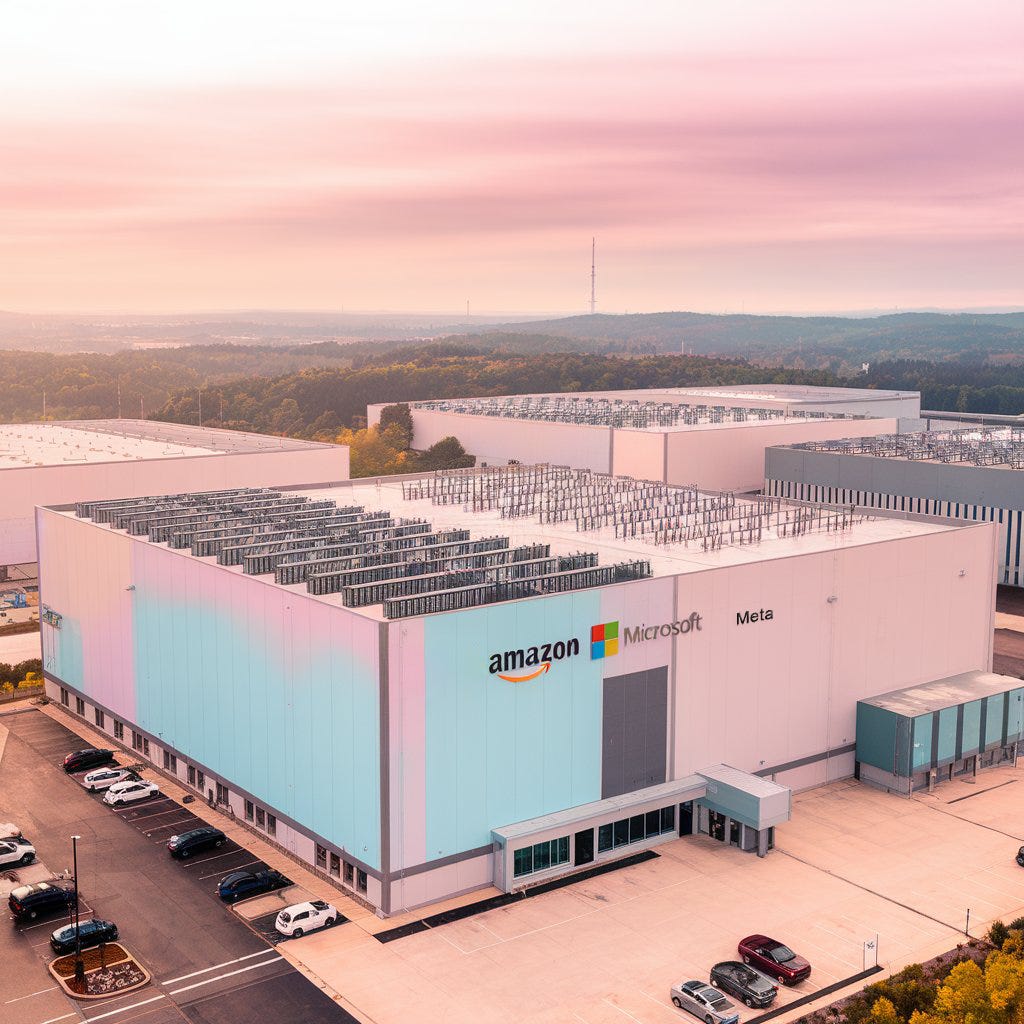Can Meta, Microsoft, and Amazon’s $390B AI Push Reshape the U.S. Power and Data Center Landscape?
A trillion-dollar infrastructure shift is unfolding not in software, but in steel, silicon, and the electric grid.
Welcome to Global Data Center Hub. Join 1600+ investors, operators, and innovators reading to stay ahead of the latest trends in the data center sector in developed and emerging markets globally.
There’s something different about this tech cycle.
It’s not about apps.
Not cloud platforms.
Not even AI models.
It’s about real estate, power substations, and thermal cooling systems.
In 2025, Meta, Microsoft, Amazon, and Alphabet are expected to spend over $390 billion on infrastructure.
That figure isn’t for headlines. It’s concrete, copper, and GPUs.
And much of that spend especially Amazon and Microsoft’s is flowing straight into the U.S. grid and land markets.
If you want to understand where this cycle is going, don’t look at ChatGPT.
Look at North Carolina, Pennsylvania, Virginia, and Louisiana.
That’s where the future of AI is being poured megawatt by megawatt into the ground.
This isn’t cloud growth. It’s a new utility layer.
Amazon is investing $10B in North Carolina and $20B in Pennsylvania some of it directly adjacent to nuclear power plants.
Microsoft is committing $80B globally, with more than half of it landing in the U.S.
Meta has raised its 2025 capex guidance to $64–72B, with facilities like the 2GW “Hyperion” project in Louisiana expected to be among the largest single-user AI campuses in the country.
These aren’t extensions of their existing cloud businesses.
They’re building a new foundational layer for the 21st-century economy.
Not software, but infrastructure.
What they’re building is intelligence as a utility.
And that utility needs land, chips, and an enormous amount of electricity.
The U.S. is the primary battleground.
By mid-2025, over 50% of global hyperscale AI infrastructure spend is expected to be deployed in the United States.
Why?
Access to scalable power markets like PJM and ERCOT
Favorable permitting environments in states like Georgia, Texas, and Ohio
A mature and fragmented utility landscape that allows hyperscalers to negotiate directly with generation owners
Political alignment across parties to support domestic AI leadership
The result: a land and power rush not seen since the early internet buildout of the 1990s except this time, the cost per site is measured in billions, not millions.
Power is the new bottleneck
Here’s what’s changing under the surface:
Traditional data centers drew 5–20 megawatts.
AI facilities now need 100–300 MW per site.
Some facilities like Meta’s in Louisiana are targeting 2 GW.
This is forcing hyperscalers to lock in long-term power deals, including:
Co-locating near nuclear (Amazon)
Partnering with hydropower players like Brookfield (Alphabet)
Signing 10GW+ in PPAs for solar, wind, and battery backup (Meta)
But even that may not be enough.
According to ERCOT, data center demand in Texas alone could exceed 50 GW by 2030. That’s more than double what’s available today.
The U.S. power grid fragmented, overburdened, and slow-moving is now being forced into the AI era.
And the hyperscalers are not waiting.
They’re becoming energy companies by default.
Transmission grid constraints are becoming as strategically important as GPUs and they’re already reshaping where and how AI campuses are built.
This is a land grab, too
The physical footprint of AI infrastructure is staggering.
Amazon is acquiring land parcels large enough to support multi-gigawatt campuses, with room for future buildouts.
Meta is securing zoning and power interconnection years in advance, often before model training needs are even forecast.
Microsoft has begun pre-permitting “AI-ready” sites with edge-to-core flexibility, designed for both training and inference.
In markets like Virginia, Arizona, and parts of the Midwest, land prices around substations and fiber routes are up 30–60% YoY.
This isn’t just infrastructure planning.
It’s industrial strategy.
With Tier-1 markets tightening, land near substations and fiber routes has become the new gold rush.
What does this mean for everyone else?
Three things.
Expect rising energy costs. Residential power prices are already rising faster than the national average in 8 of the top 9 data center markets.
Expect tighter real estate markets. Industrial land near transmission lines and fiber routes is being bought up in bulk years before it’s needed.
Expect geopolitics to follow. The U.S. is winning this phase of the AI race not because of its models but because of its land, power, and capital.
And that might be the most overlooked shift of all.
Final thought
The question isn’t whether these AI investments will reshape the U.S. grid.
They already are.
The real question is:
What happens when AI doesn’t just need data but territory?
Because that’s where we’re headed.
And only a few players have the capital, scale, and foresight to dominate this new map.

